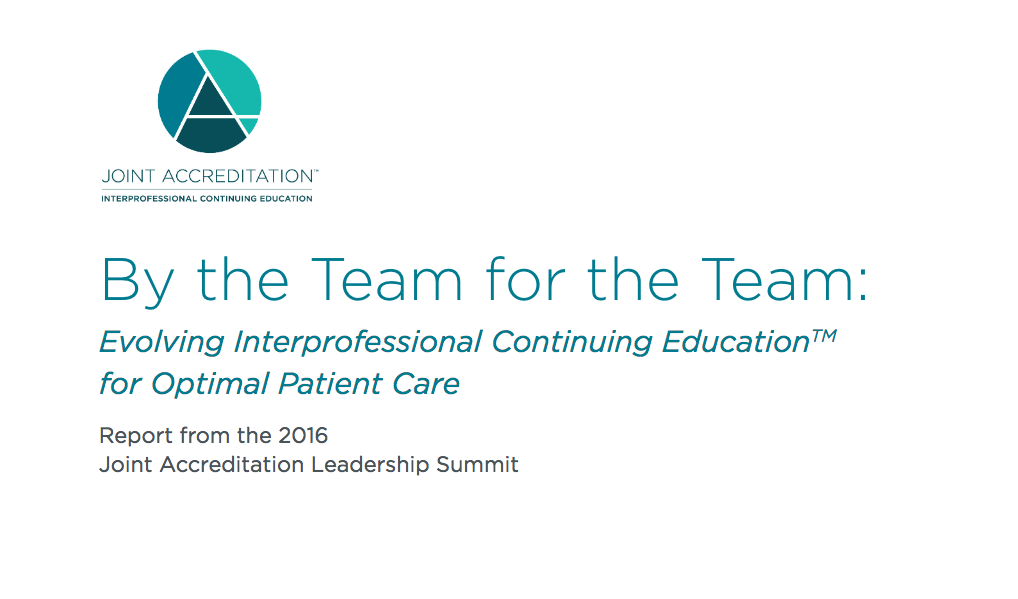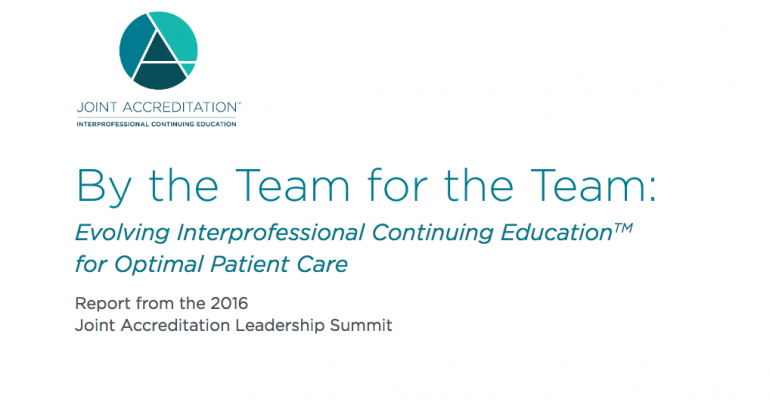 When participants from 28 healthcare organizations and continuing medical education, pharmacy, and nursing accreditors gathered in Chicago last spring for the Leadership Summit for Jointly Accredited Providers, they were on a mission to figure out how to bring out the best in interprofessional collaborative practice through continuing education.
When participants from 28 healthcare organizations and continuing medical education, pharmacy, and nursing accreditors gathered in Chicago last spring for the Leadership Summit for Jointly Accredited Providers, they were on a mission to figure out how to bring out the best in interprofessional collaborative practice through continuing education.
The result of their labor is a report that outlines some key challenges, recommendations, and best practices, along with a series of videos of educators talking about what they do and why they do it—what brings them pride and joy in their work. (Download the PDF of the report here, and view the videos here.)
All of the hospitals, health systems, medical schools, specialty societies, education companies, and government agencies represented at the Summit either already had received or were in the process of obtaining Joint Accreditation for Interprofessional Continuing Education. Joint Accreditation is a seven-year-old collaboration between the Accreditation Council for CME, the Accreditation Council for Pharmacy Education, and the American Nurses Credentialing Center—all of which also participated in the Summit—designed specifically to improve healthcare for patients by involving the entire care team in planning and taking part in CE.
8 Key Recommendations
The Summit began by having participants discuss the staffing, reporting, and funding structures for IPCE in their organizations. While IPCE programs vary depending on the organization, the group did find some common best practices. The eight biggest takeaways for creating and sustaining an IPCE program that is inclusive, patient-centered, and results-oriented were:
1. Develop buy-in from leadership. It is vital to “be clear and explicit about your mission … about what you do and why” when communicating with leadership, the report says. Explain to them how IPCE helps to identify and close gaps that aren’t apparent when team members work in silos, and how IPCE can not only improve patient care, but also streamline processes, save time and resources, and potentially help mitigate the risk of a lawsuit by improving safety and quality initiatives.
2. Support your organization’s strategic mission. It’s important to identify your organization’s major strategic goals and align your IPCE program to support and contribute to quality, safety, professionalism, team communications, and process improvement initiatives that already are a priority for your organization.
3. Build your IPCE team and model best practices. Once your IPCE program is established and working well, consider expanding the program to include professionals who might not ordinarily be included in healthcare IPCE, such as social workers, physical therapists, administrators, quality improvement/patient safety specialists, even support services such as housekeeping. Bring in new voices, whether that means reaching out to new volunteers and staff, or even, for an association, expanding membership to new types of professionals who are typically involved in caring for the patients your primary members treat.
4. Involve patients. Patients are an integral part of the IPCE team, so always ask yourself which professionals are important to patients and patient outcomes. “Consider including the patient as planner, teacher, and learner in your IPCE,” the report says. “Think about including education for patients.”
5. Implement a phased-in approach. It can be difficult to get everyone’s buy-in for a big ICPE program push. Participants recommend taking a phased-in approach and using pilot projects to test new ideas. “A phased-in, organic approach to change will be less threatening,” the report says. “Remember that ICPE is an evolution, not an event.”
6. Focus on quality. By not having to produce multiple activities for multiple professions, Joint Accreditation enables CE providers to put their time and resources into creating high-quality, strategic team interventions. IPCE programs should use all the pedagogical approaches in their arsenal to ensure their team interventions target all types of learners, and employ technology that will help support the educational goals.
7. Measure outcomes. The report includes numerous cases of IPCE that improved knowledge, competence, and patient care in both clinical and nonclinical areas, but participants also stressed that outcomes data is not easy to come by, especially for organizations that don’t directly provide clinical care. Recommendations include focusing on those who do answer the surveys—don’t obsess over the low response rate, they said. “If even one healthcare professional achieves and maintains an improvement as a result of an IPCE activity, it may not be a significant enough outcome to publish in a study, but it will be quite significant for that healthcare professional’s patients.” It also helps to set reasonable, achievable, and measurable goals.
8. Communicate the value of IPCE. Don’t be shy about spreading the word. Share your outcomes data and examples of your successes and challenges with others in healthcare education and throughout the healthcare community. “Be an IPCE champion,” the report says. “Educate your leadership and stakeholders about the contributions of IPCE to improving healthcare delivery, team performance, and patient care.”



